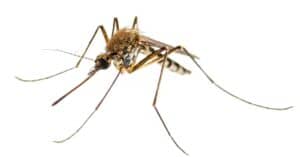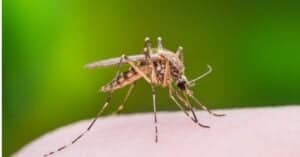South Dakota’s flying terrors might surprise you! With its sprawling prairies, stunning mountains, and glacial lakes, South Dakota boasts some absolutely amazing scenery. Just looking at the photos, it seems a pretty safe place to live and visit. However, dangerous animals do reside in the state!
South Dakota experiences cold, dry winters and warm, sometimes humid summers. This weather tends to allow tourists plenty of time to see its wonderful natural beauty. From the iconic Mount Rushmore to the Badlands National Park, there’s plenty to experience and explore.
Not only that, but the state is also home to a great variety of animals. A wildlife photographer and birdwatcher’s paradise, hundreds of unique species call South Dakota home. Some are dangerous to humans and pets. Cougars, bears, wolves, and coyotes all make their homes in South Dakota. These land-dwelling predators rank as some of the most dangerous animals in the state. While these predators keep their feet firmly on the ground, some airborne creatures pose a threat, too. Let’s check out the top South Dakota flying terrors from least to most dangerous!
#3: Owl Attacks in South Dakota – Flying Terrors in the Night
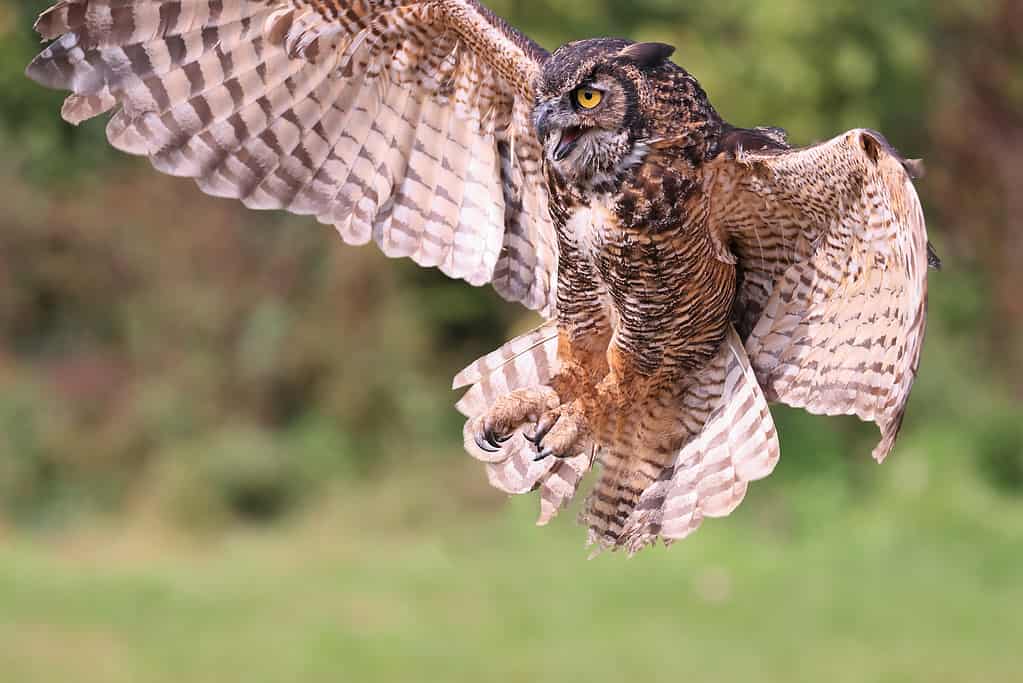
Owls have sharp talons and beaks for latching on and killing their prey.
©Vladone/iStock via Getty Images
Owls can be dangerous flying terrors in South Dakota. Reports of them attacking both humans and pets litter the internet and news articles in the state.
Owls are nocturnal, silent killers that typically prey on small mammals like mice and rats. However, a large owl easily carries off a pet cat or small dog for its next meal. Even if the owl doesn’t carry the animal away and eat it, they inflict significant injury with their sharp talons and beaks. This can lead to terrible infections, including sepsis (or infection that enters the bloodstream) which can be deadly.
The great gray owl is one of the largest owl species in the state. Reaching body lengths of up to 33 inches and wingspans of 5 feet, this massive owl species weighs only about 2–3 pounds. They can carry prey up to about 1.4 times their own weight. This includes young/small cats and toy-breed dogs (think teacup Yorkshire Terriers and Chihuahuas). They sometimes attack farm animals like chickens and ducks, as well.
Great horned owls also live in South Dakota and claim the title of the largest owl species there. These owls tend to be more aggressive and are featured in attack reports more often. They average about 4 pounds and can carry prey weighing up to 9 pounds or so. This includes some fully grown cats and several dog breeds. They also might attack farm birds and pet rabbits if out in the open.
A Crazy Slew of Owl Attacks
One story in September 2022 reported a great horned owl at Lake Okobojo attacking residents and tourists. Several people reported the attacks, and wildlife officers attempted to scare the owl away. Their attempts failed miserably.
Finally, after it latched onto a woman’s leg with its talons, residents caught the creature in a fishing net. The attacked woman held on tight to the owl’s legs and waited for help despite being severely injured. The residents turned the offending owl over to wildlife officers. They planned to release it far away from the community in hopes that it would not return.
Other owl attacks have been reported throughout the United States. Contrary to popular belief, most owl attacks are not an attempt to obtain an easy meal. Actually, a majority of them result from the owl attempting to scare away threats to either themselves or their nest. Owl pairs defend their nest fiercely together to help ensure their babies survive.
#2: Bats – Rabid Flying Terrors in South Dakota

The eastern red bat is one of 10 species found in South Dakota.
©Elliotte Rusty Harold/Shutterstock.com
If you thought owls were South Dakota’s main flying terrors, you’ll be horrified to know that 10 species of bats live there, too. Some varieties include the big brown bat, eastern red bat, and the long-legged bat. These creatures carry a wide variety of diseases, including viral and bacterial infections. Some are zoonotic (or transferrable from animal to human and vice versa). Rabies is the most serious disease bats carry, and it can infect pretty much any warm-blooded animal.
Rabies
It might put your mind at ease knowing only about 6% of bats tested in the U.S. carried rabies. Nevertheless, the risk is still very real. Rabies testing is performed on brain tissue; therefore, the tested animal does lose its life. Perhaps a better ending to dying from rabies, though.
Rabies is a viral disease transmitted through bites and scratches from infected animals to both other animals and humans. The fatality rate of rabies infections is nearly 100% meaning almost every animal that catches it dies from the disease. While most human rabies infections occur from dog bites, any infected animal can pass the disease on. However, according to the Centers for Disease Control and Prevention (CDC), human deaths from rabies have declined steadily since 1970.
Some symptoms of rabies include fever, excessive salivation (drooling or foaming at the mouth), muscle spasms or seizures, paralysis, and mental confusion. There are two of rabies: paralytic type (dumb rabies) and encephalitic type (furious rabies).
Furious Rabies – Encephalitic Type
Furious rabies usually presents suddenly, and symptoms progress quickly. Both humans and other animals that have this type of rabies become aggressive and hydrophobic. A literal translation of this term is “afraid of water.” Both of these conditions are thought to allow for a higher likelihood of spreading the disease. That’s because aggressive animals are more likely to bite, and those refusing water are less likely to rinse the virus from the mouth before biting.
Dumb Rabies – Paralytic type
Dumb rabies occurs most often with a bite from infected bats (or in people who lack full vaccination). Patients infected with this type typically present with paralysis that slowly works its way to the respiratory system and suffocates the infected. They also suffer from fever and, in humans, profuse sweating.
#1: Mosquitos – The Easily-Forgotten South Dakota Flying Terrors
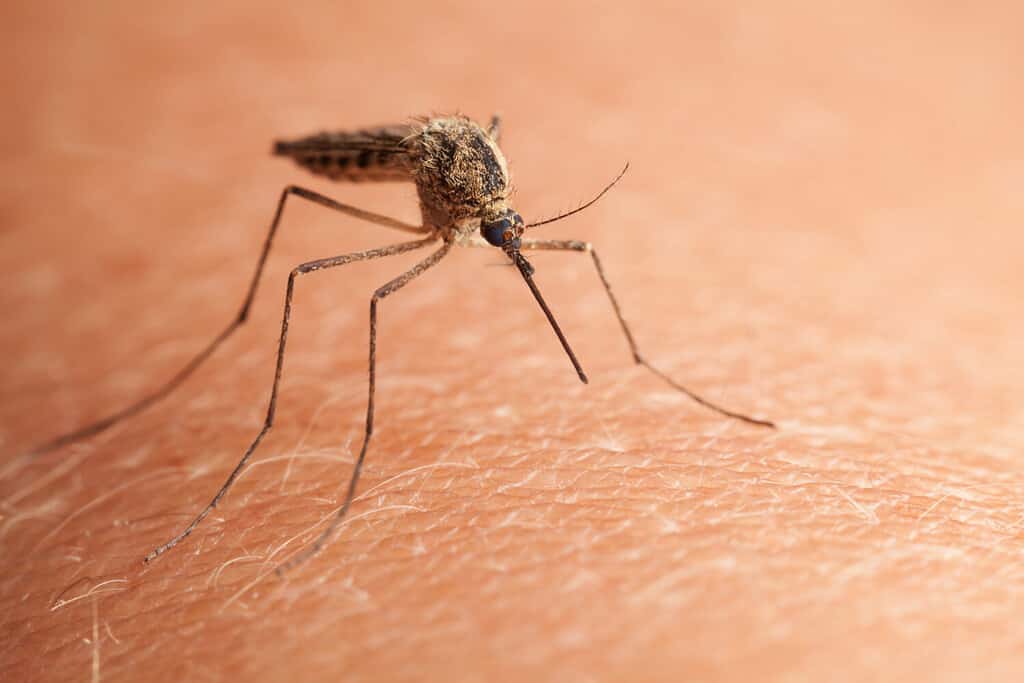
Mosquitos use the long, needle-like appendage from their mouth (proboscis) to pierce the skin and consume a blood meal.
©Anest/Shutterstock.com
Mosquitos are tiny, irritating insects that drink blood and leave behind itchy red bumps that go away in a few days’ time. Most of us don’t think too much of them. However, mosquito bites claim the lives of more than 700,000 people each year. They carry diseases that kill both humans and animals.
South Dakota is rated as one of the top places to suffer a bite from these flying terrors in the U.S. First and second place go to Louisiana and Florida. The mosquito problem is so bad in South Dakota that several news articles were published about keeping them away. They suggested planting foliage such as lemongrass, mint, and marigold. Many cities in the state also reported plans to begin seasonal spraying for the little buggers.
Mosquitos transmit disease through their bite. Did you know only female mosquitos bite? They also only bite when they are ready to lay their eggs. They need a blood meal to intake the protein they require for egg development.
How Do Mosquitos Spread Disease?
When a mosquito female inserts her proboscis (the long needle-like appendage on their face) into the skin, they inject a numbing agent to prevent the host from noticing the bite. The numbing agent wears off after a while, and the skin becomes irritated and itchy.
When a mosquito bites, she regurgitates a bit of blood she’s already consumed along with the numbing agent. The infected blood enters the bloodstream and allows the infection to pass to the new host. Once in the bloodstream, the infection reproduces and causes illness.
Let’s learn a bit about the most deadly disease mosquitos spread!
Malaria
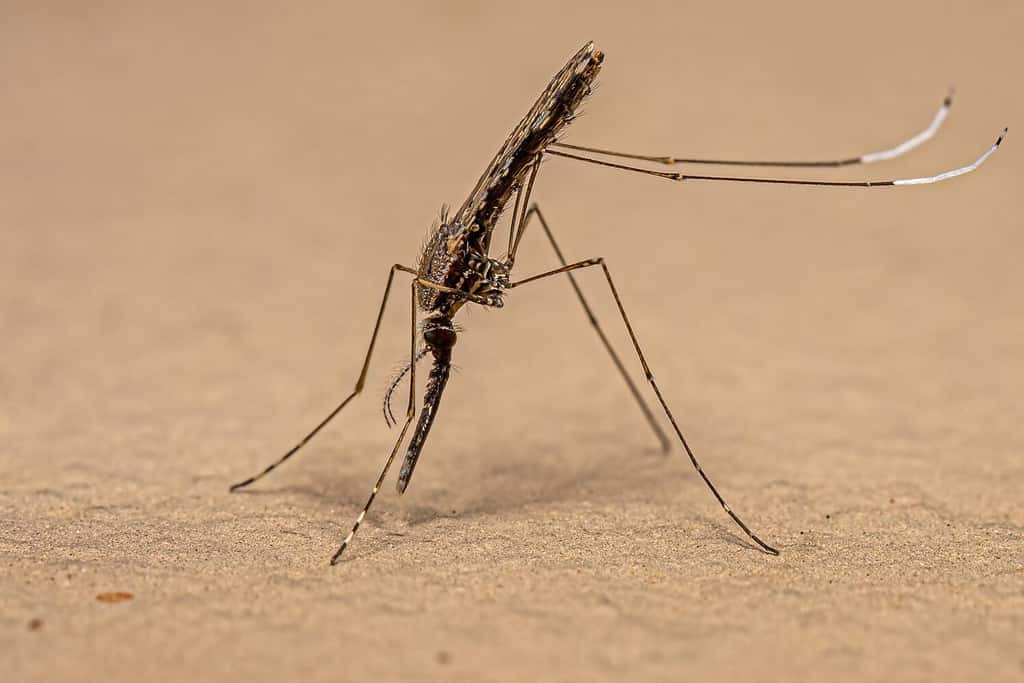
Anopheles mosquitos are the most common carriers of malaria.
©Vinicius R. Souza/Shutterstock.com
The number one most worrying disease spread by mosquitos remains malaria. Symptoms include fever, chills, headache, muscle aches, nausea, vomiting, and diarrhea. It can also cause jaundice (yellowing of the skin) and anemia (the loss of red blood cells).
World Health Organization’s 2021 health statistics indicate an estimated 247 million cases worldwide. Although malaria is curable with quick and effective treatment, WHO also stated approximately 619,000 people died of the disease that same year.
The CDC reported a total of 1,505 cases of malaria in the U.S. in 2007. Only one case was in South Dakota. The main concern with these cases is that many of them were locally acquired. That means the people affected did not travel outside the country. However, while malaria is in the U.S., public health advisors say it’s not a major concern.
What Prevents Malaria?
There are medications humans can take to prevent malaria, but the best prevention is avoiding mosquito bites entirely.
Malaria is extremely common in Central Africa. In fact, it’s so common that some humans in Africa (and of African descent) develop a disease called sickle-cell anemia. This disease causes red blood cells to lose their proper shape, which prevents malaria from reproducing inside the cells.
While sick-cell anemia presents its own problems, people with only one copy of the disease within their DNA (heterozygous carriers) do not contract the disease or malaria. While this information is widely considered hypothetical, one study expressed that sickle-cell anemia is one of the most widely studied conditions in relation to malaria.
Heartworm
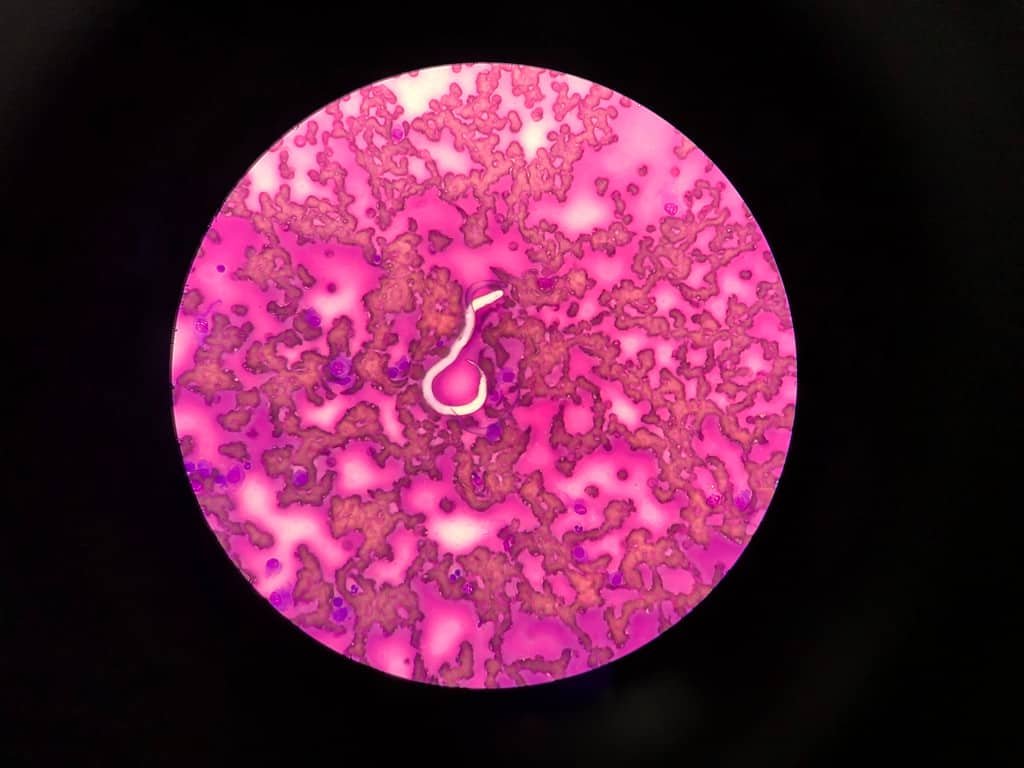
Microfilaria (or heartworm larvae) can be detected by looking at a drop of the patient’s blood under a microscope.
©wimala namket/Shutterstock.com
Heartworm is transmitted by infected mosquitos to dogs, cats, ferrets, and some wild animals such as wolves, coyotes, foxes, sea lions, and even the occasional human. While heartworm prevention medications are widely available for dogs and cats, other animals do not have these benefits.
Heartworm incidence maps for 2022 show an average of 1–5 cases per veterinary clinic in South Dakota caused by these flying terrors. Somewhere between 160 and 460 veterinarians worked in the state as of 2022, the Bureau of Labor Statistics reports. Assuming roughly 2–3 veterinarians work for each clinic, we can calculate that somewhere between 80 to more than 1,000 cases of heartworm disease were reported in 2022 in South Dakota. That’s a ton of heartworm cases!
Once an animal becomes infected with heartworm, aggressive treatment must ensue to save them. Heartworm treatment is currently only available for dogs. The medication is not safe for cats or ferrets. The process of treatment is long, extremely painful, and very expensive. In many cases, dogs require hospitalization, crate rest, sedatives, and extensive pain medication to survive the treatment.
Heartworm Prevention
Dr. Shelly Wyatt, a Doctor of Veterinary Medicine in Gulfport, MS, told AZ Animals, “Unfortunately, heartworms are becoming resistant to the medications we are using to prevent them. Macrocyclic lactones, such as milbemycin and ivermectin, work by killing heartworm larvae before they can mature into adults.” The process is a bit more complicated than that, but that’s the short version.
So, the preventions we give are actually retroactive treatments (or treatments given after infection has already occurred). Once the larvae (microfilaria) mature into adults, more drastic measures are necessary.
Ivermectin is the active ingredient in Heartgard® and Heartgard® Plus. Milbemycin is used by several brands such as Interceptor® Plus, Sentinel®, and Trifexis®. All of these medications require a veterinary prescription. These medications are generally considered safe for pets, though some brands that combine them with flea and tick preventatives (Simparica® Trio, for instance) may increase the risk of seizures.
Where Are Heartworms a Problem?
The American Heartworm Society confirms that heartworm has spread to all 50 states, including Hawaii and Alaska. Many more cases occur in the Southeast than in other places. Mosquitos bite year-round, and pets that live only indoors aren’t safe, either. Because of this, veterinarians recommend owners give heartworm prevention every month with no skipped doses, even when it’s cold outside.
West Nile Virus
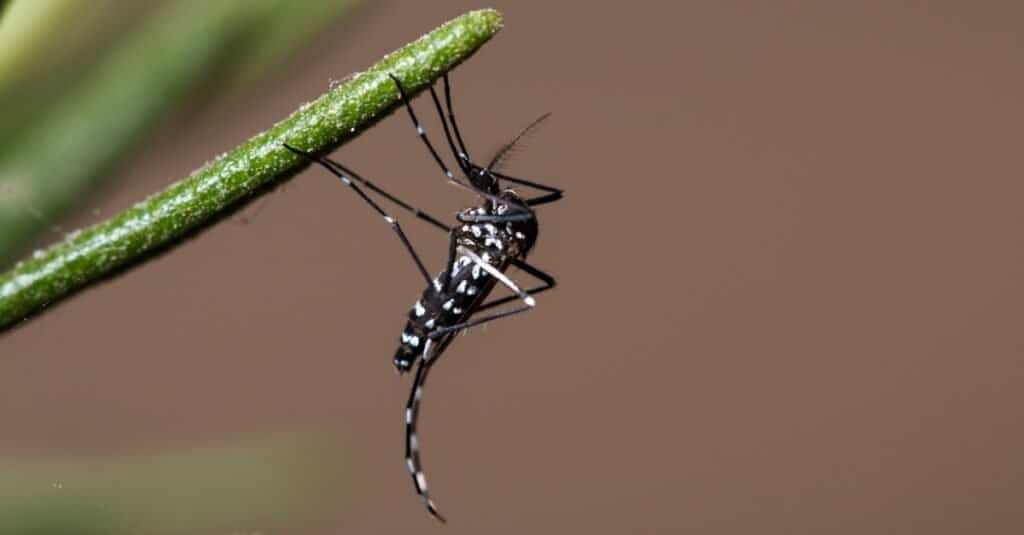
The Asian
tiger
mosquito is responsible for transmitting several diseases, including the West Nile virus.
©Oliver Spiteri/Shutterstock.com
The most relevant disease these flying terrors present in South Dakota is the West Nile Virus. This disease causes fever, encephalitis (inflammation of the brain), and meningitis (inflammation of the lining of the brain and spinal cord). Fortunately, only about 20-30% of people infected with West Nile Virus develop symptoms. This makes them asymptomatic carriers. Unfortunately, the disease can still spread from person to person through mosquito bites, even though they’re showing no symptoms. Only about 1% of people infected have severe symptoms and develop neurological illness.
There is no treatment or prevention available for humans for West Nile Virus. Vaccines do exist for horses though research for an effective vaccine for humans is ongoing. Because West Nile infection is a virus, the vaccine cannot prevent the disease entirely. It only reduces the effect should the horse become infected.
Summary of South Dakota Flying Terrors
While creatures on the ground pose significant threats to humans in South Dakota, the flying terrors we’ve discussed might be altogether much more alarming. Maintain awareness of your surroundings, and make sure to wear bug spray!
| Rank: Most to Least Dangerous | South Dakota Flying Terror | What’s the Danger? |
|---|---|---|
| 1 | Mosquitos | Transmits a whole host of deadly diseases to both humans and animals |
| 2 | Bats | Transmits diseases including Rabies which is nearly 100% deadly to both humans and animals |
| 3 | Owls | Attacks on humans and animals leave deep wounds prone to infection |
The photo featured at the top of this post is © iStock.com/panom
Thank you for reading! Have some feedback for us? Contact the AZ Animals editorial team.




